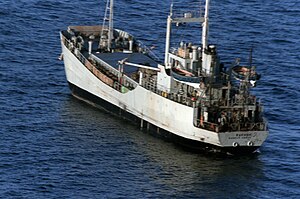Iran Ajr
This article needs additional citations for verification. (January 2013) |
 Iran Ajr, 1986
| |
| History | |
|---|---|
| Name | Iran Ajr |
| Builder | Teraoka Shipyard - Minamiawaji, Japan[1] |
| Christened | Arya Rakhsh[1] |
| Acquired | by purchase, 1978 |
| Renamed | Iran Ajr (1980) |
| Identification | IMO number: 7807196 |
| Fate | Seized and scuttled by U.S. Navy, 26 September 1987 |
| Notes | Originally acquired by Imperial Iranian Navy as part of pre-1979 Revolution defense build-up. Was intended to be the first of a class of four. |
| General characteristics [2] | |
| Type | Landing ship/Minelayer |
| Displacement | |
| Length | 53.85 m (176 ft 8 in) |
| Beam | 10.81 m (35 ft 6 in) |
| Draught | 3 m (9 ft 10 in) |
| Propulsion | 2 × diesel engines, 2 screws |
| Speed | 11 knots (20 km/h; 13 mph) |
| Complement | 30 |
| Armament |
|
Iran Ajr, formerly known as the Arya Rakhsh, was a Japanese-built landing craft used by Iran to lay naval mines during the Iran–Iraq War.[3] Built in 1978, the 614-ton, 54-meter ship was powered by two diesel engines and featured a bow ramp for unloading cargo. She was scuttled in 1987.
Iran–Iraq War
On 21 September 1987, U.S. forces involved in Operation Prime Chance – the covert part of Operation Earnest Will, the mission to protect U.S.-flagged petroleum-carrying ships in the Persian Gulf – tracked Iran Ajr and dispatched United States Army helicopters from the United States Navy guided-missile frigate USS Jarrett (FFG-33) to shadow her. When the aviators reported that people aboard Iran Ajr were laying mines, the U.S. commander in the Persian Gulf ordered the pilots to "stop the mining." The helicopters fired on the ship, killing some of the crewmen and chasing others into the water. A team of United States Navy SEAL commandos later boarded the ship, confirmed the presence of mines, and detained the surviving Iranians. On 26 September, EOD MU5 Detachment 5 scuttled the ship in international waters.
When the U.S. Navy guided-missile frigate USS Samuel B. Roberts (FFG-58) struck a mine in the Persian Gulf in April 1988, U.S. Navy explosive ordnance specialists matched the serial numbers of nearby unexploded mines to the ones aboard Iran Ajr. This evidence of Iranian involvement in the mining of Samuel B. Roberts led to the biggest surface-warfare naval battle since World War II, the retribution campaign of 18 April 1988 called Operation Praying Mantis.[3]
The captured colors of Iran Ajr are in the U.S. Navy Museum.
References
- ^ a b "7807196 Iran Ajr". Maritime Connector. Archived from the original on 4 February 2018. Retrieved 29 June 2015.
- ^ "Iran Ajr/Hejaz Class". globalsecurity.org. 2012. Retrieved 29 August 2012.
- ^ a b Peniston, Bradley (2006). "Capturing the Iran Ajr". No Higher Honor. Retrieved 29 June 2015.
Further reading
- Wise, Harold Lee (2007). Inside the Danger Zone: The U.S. Military in the Persian Gulf 1987-88. Annapolis: Naval Institute Press. ISBN 978-1-59114-970-5.
- Crist, David (2012). The Twilight War: The Secret History of America's Thirty-Year Conflict With Iran. New York: The Penguin Press. ISBN 978-1-59420-341-1.
External links
- The attack on the Iran Ajr
- Another narration of the attack
- Photos of the captured Iran Ajr and its detainees aboard U.S. Navy warships
- Amphibious warfare vessels of Japan
- Minelayers of Japan
- Amphibious warfare vessels of the Islamic Republic of Iran Navy
- Ships built in Japan
- 1978 ships
- Iran–Japan relations
- Minelayers of the Islamic Republic of Iran Navy
- Operations involving special forces
- United States Navy in the 20th century
- Iran–United States relations
- Shipwrecks in the Persian Gulf
- Maritime incidents in 1987
- Vessels captured by the United States Navy
- Iran–Iraq War naval ships of Iran
- Scuttled vessels
